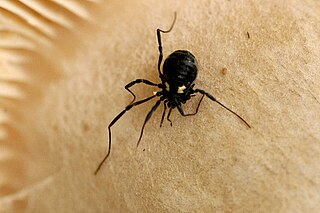
Melanosuchus is a genus of caiman. The black caiman of South America is the sole extant (living) species, and is the largest living member of the subfamily Caimaninae, as well as the entire alligator family Alligatoridae.

Incertae sedis or problematica is a term used for a taxonomic group where its broader relationships are unknown or undefined. Alternatively, such groups are frequently referred to as "enigmatic taxa". In the system of open nomenclature, uncertainty at specific taxonomic levels is indicated by incertae familiae, incerti subordinis, incerti ordinis and similar terms.

Chrysaora is a genus of jellyfish, commonly called the sea nettles, in the family Pelagiidae. The origin of the genus name Chrysaora lies in Greek mythology with Chrysaor, brother of Pegasus and son of Poseidon and Medusa. Translated, Chrysaor means "he who has a golden armament."
Brasilotyphlus is a genus of caecilians in the family Siphonopidae. It was considered monotypic, containing only the species Brasilotyphlus braziliensis. However, two recently described species, Brasilotyphlus guarantanus and Brasilotyphlus dubium, have been placed in this same genus. All three species are endemic to Brazil. This genus has also been suggested as paraphyletic to Microcaecilia.
Ranitomeya rubrocephala is a species of frog of doubtful taxonomic status in the family Dendrobatidae.
Telmatobius dankoi, also known as the Loa water frog, is a species of critically endangered aquatic frog in the family Telmatobiidae. It is endemic to Chile and is only known from its type locality near Calama, in the El Loa province. Only 14 individuals are known from captivity following the destruction of its habitat prior to 2019, so it may already be extinct in the wild. However, it is doubtfully distinct from Telmatobius halli and thus may not be a distinct species.
Telmatobius halli is a species of frog in the family Telmatobiidae. It is endemic to northern Chile and only known from its type locality near Ollagüe. The specific name halli honors Frank Gregory Hall, an American specialist on the effects of high altitudes on human body and collector of the type series. Its common name is Hall's water frog.
Telmatobius vilamensis is a species of frog in the family Telmatobiidae. It is endemic to northern Chile and only known from its type locality, Río Vilama near San Pedro de Atacama. The specific name vilamensis refers to the type locality. It may already be extinct, although it is doubtfully distinct from Telmatobius halli.

The Nemastomatidae are a family of harvestmen with about 170 described species in 16 recent genera. Several fossil species and genera are known.
Glishades is a genus of hadrosauroid dinosaur that lived in the Late Cretaceous in North America. It is based on AMNH 27414, two partial premaxillae discovered in the Upper Cretaceous rocks of the upper Two Medicine Formation in Montana, dated to about 74.5 million years ago. Cladistic analysis conducted by Prieto-Márquez suggests that Glishades is a non-hadrosaurid hadrosauroid, probably a sister taxon to Bactrosaurus johnsoni. The type species is Glishades ericksoni.
Brasilotyphlus guarantanus is a species of caecilian in the family Caeciliidae. It was described in 2009 from a specimen collected in the north part of Mato Grosso, Brazil.
Otitoma is a genus of sea snails, marine gastropod mollusks in the family Pseudomelatomidae.

The Nemacheilidae, or stone loaches, are a family of cypriniform fishes that inhabit stream environments, mostly in Eurasia, with one genus, Afronemacheilus found in Africa. The family includes about 790 species.
Metaperipatus is a genus of velvet worms in the family Peripatopsidae that contains two species found in Chile, including Metaperipatus inae. This genus was created by the American zoologist Austin Hobart Clark in 1913 to contain the type species, M. blainvillei. Authorities believe M. blainvillei is a species complex, however, and some consider M. blainvillei a nomen dubium.
Chrysaora pentastoma is a species of jellyfish from the family Pelagiidae. This small sea nettle has a strong sting and it is found in coastal waters of eastern South Australia.

Catasticta sibyllae is a butterfly in the family Pieridae. It is only known from two sites in western Panama and is represented by a single male specimen from each site. It was first described by Shinichi Nakahara, Pablo Sebastián Padrón, and John R. MacDonald in 2018. The first specimen was caught in the 1980s and stowed in a drawer in the National Museum of Natural History.
Dysaphis karyakini is a species of aphid found near Luvenga, Murmansk province, Russia. It was named in honor of Russian ornithologist A. S. Koryakin (1954–2014). The species was described in 2018.
Cyrtodactylus aunglini, also known commonly as the Kyauk Nagar Cave bent-toed gecko, is a species of lizard in the family Gekkonidae. The species is endemic to Myanmar.

Asianopis is a genus of Asian net-casting spiders first described by Y. J. Lin, L. Shao and A. Hänggi in 2020.






